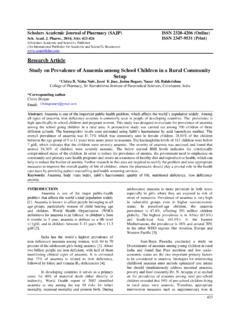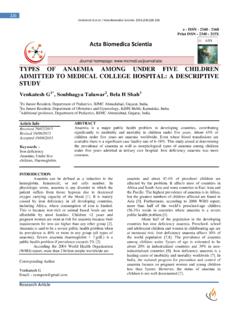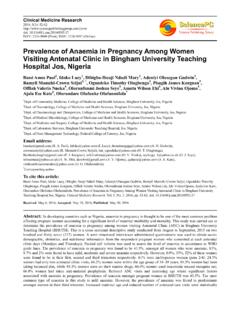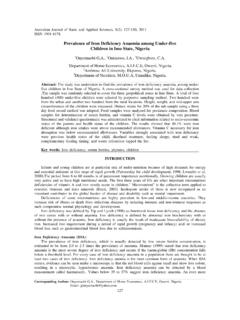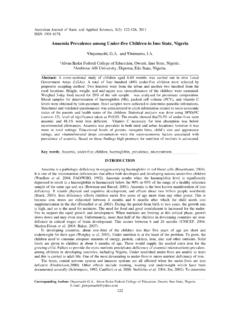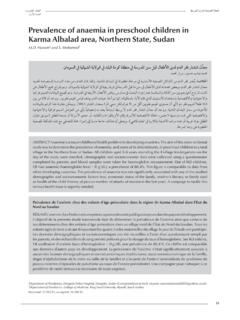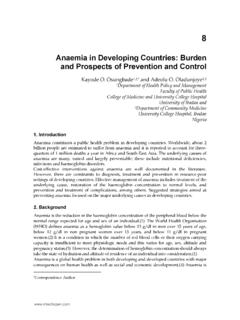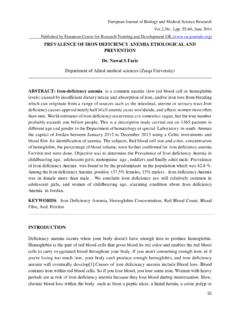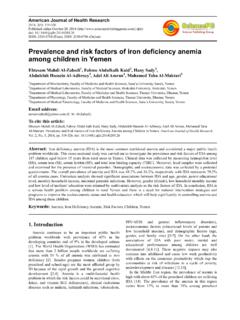Transcription of THE GLOBAL PREVALENCE OF ANAEMIA IN 2011 - WHO
1 THE GLOBAL PREVALENCEOF ANAEMIA IN 2011 THE GLOBAL PREVALENCE OF ANAEMIA IN 2011iiWHO Library Cataloguing-in-Publication DataThe GLOBAL PREVALENCE of ANAEMIA in epidemiology. statistics and numerical data. , Preschool. Health Organization. ISBN 978 92 4 156496 0 (NLM classification: WH 155) World Health Organization 2015 All rights reserved. Publications of the World Health Organization are available on the WHO website ( ) or can be purchased from WHO Press, World Health Organization, 20 Avenue Appia, 1211 Geneva 27, Switzerland (tel.: +41 22 791 3264; fax: +41 22 791 4857; e-mail: Requests for permission to reproduce or translate WHO publications whether for sale or for non-commercial distribution should be addressed to WHO Press through the WHO website ( ).The designations employed and the presentation of the material in this publication do not imply the expression of any opinion whatsoever on the part of the World Health Organization concerning the legal status of any country, territory, city or area or of its authorities, or concerning the delimitation of its frontiers or boundaries.)
2 Dotted and dashed lines on maps represent approximate border lines for which there may not yet be full agreement. The mention of specific companies or of certain manufacturers products does not imply that they are endorsed or recommended by the World Health Organization in preference to others of a similar nature that are not mentioned. Errors and omissions excepted, the names of proprietary products are distinguished by initial capital reasonable precautions have been taken by the World Health Organization to verify the information contained in this publication. However, the published material is being distributed without warranty of any kind, either expressed or implied. The responsibility for the interpretation and use of the material lies with the reader. In no event shall the World Health Organization be liable for damages arising from its use.
3 Design and layout: Elysium Printed by the WHO Document Production Services, Geneva, SwitzerlandSuggested citationWHO. The GLOBAL PREVALENCE of ANAEMIA in 2011. Geneva: World Health Organization; GLOBAL PREVALENCE OF ANAEMIA IN 2011 THE GLOBAL PREVALENCE OF ANAEMIA IN 2011iiiCONTENTSACKNOWLEDGEMENTS SCOPE AND PURPOSE 1 BACKGROUND 1 METHODS 1 Identification of data sources for blood haemoglobin concentration and ANAEMIA hrough a systematic review; accessing and extracting data.
4 And systematically assessing the population representativeness of data Adjustment of data on blood haemoglobin concentrations for altitude and smoking Application of a statistical model to estimate trends in the distribution of blood haemoglobin concentrations and their uncertainties RESULTS 3 Population coverage The proportion of the population and number of individuals with ANAEMIA Classification of countries by degree of public health significance of ANAEMIA , based on blood haemoglobin concentration The PREVALENCE of ANAEMIA attributed to iron deficiency DISCUSSION 5 CONCLUSIONS 6 REFERENCES 7 ANNEX 1.
5 WHO MEMBER STATES GROUPED BY REGION, AS OF JANUARY 2011 15 ANNEX 2. RESULTS BY UNITED NATIONS REGION, AS OF 2011 17 ANNEX 3. NATIONAL ESTIMATES OF ANAEMIA FOR THE YEAR 2011 192342425ivTHE GLOBAL PREVALENCE OF ANAEMIA IN 2011ivACknowledgementsJuan Pablo Pe a-Rosas, Lisa Rogers and Gretchen A Stevens oversaw the preparation of this report. The World Health Organization (WHO) acknowledges the technical contributions of Marianella Anzola, Camila Chaparro and Luz Maria De-Regil in the drafting and revision of this document. We would also like to thank Florence Rusciano for her support in the preparation of the maps presented in this estimates of the PREVALENCE of ANAEMIA were produced by the Nutrition Impact Model Study Group (NIMS) for ANAEMIA , a collaboration between WHO and Imperial College London, United Kingdom of Great Britain and Northern Ireland (UK).
6 The study was supported by the Bill & Melinda Gates Foundation and the Medical Research Council of the UK. WHO would like to thank (in alphabetical order): Zulfiqar A Bhutta, Francesco Branca, Luz Maria De-Regil, Majid Ezzati, Mariel M Finucaine, Seth R Flaxman, Christopher J Paciorek, Juan Pablo Pe a-Rosas and Gretchen A Stevens for the technical input in the preparation of the also wishes to thank the many individuals, institutions, governments and nongovernmental and international agencies for providing data for the Micronutrients Database in the WHO Vitamin and Mineral Nutrition Information System (VMNIS), which was developed by the Department of Nutrition for Health and Development and is currently being maintained by the Evidence and Programme Guidance supportWHO thanks the Micronutrient Malnutrition Prevention and Control (IMMPaCt)
7 Program, United States Centers for Disease Control and Prevention and the Micronutrient Initiative for providing financial support for maintaining the VMNIS Micronutrients Database. WHO gratefully acknowledges the financial support of the Bill & Melinda Gates Foundation and the United States Agency for International Development (USAID) for its work in GLOBAL PREVALENCE OF ANAEMIA IN 2011 THE GLOBAL PREVALENCE OF ANAEMIA IN 20111sC ope And purposeThis document describes estimates of the PREVALENCE of ANAEMIA for the year 2011 in preschool-age children (6 59 months) and women of reproductive age (15 49 years), by pregnancy status, and by regions of the United Nations and World Health Organization (WHO), as well as by country. This report is based on analyses previously published (1) to estimate trends (from 1995 to 2011) in the distribution of blood haemoglobin concentrations and the PREVALENCE of ANAEMIA in these same population document may serve as a resource for estimating the baseline PREVALENCE of ANAEMIA in women of reproductive age, in working towards achieving the second GLOBAL nutrition target 2025, a 50% reduction of ANAEMIA in women of reproductive age (2), as outlined in the Comprehensive implementation plan on maternal, infant and young child nutrition and endorsed by the Sixty-fifth World Health Assembly, in resolution (3).
8 BAC kgroundAnaemia, defined as a low blood haemoglobin concentration, has been shown to be a public health problem that affects low-, middle- and high-income countries and has significant adverse health consequences, as well as adverse impacts on social and economic development (1, 4 6). Although the most reliable indicator of ANAEMIA at the population level is blood haemoglobin concentration, measurements of this concentration alone do not determine the cause of ANAEMIA . ANAEMIA may result from a number of causes, with the most significant contributor being iron Approximately 50% of cases of ANAEMIA are considered to be due to iron deficiency, but the proportion probably varies among population groups and in different areas, according to the local conditions (1, 7, 8). Other causes of ANAEMIA include other micronutrient deficiencies ( folate, riboflavin, vitamins A and B12), acute and chronic infections ( malaria, cancer, tuberculosis and HIV), and inherited or acquired disorders that affect haemoglobin synthesis, red blood cell production or red blood cell survival ( haemoglobinopathies) (9, 10).
9 ANAEMIA resulting from iron deficiency adversely affects cognitive and motor development, causes fatigue and low productivity (8, 9, 11) and, when it occurs in pregnancy, may be associated with low birth weight and increased risk of maternal and perinatal mortality (12, 13). In developing regions, maternal and neonatal mortality were responsible for million deaths in 2013 and are important contributors to overall GLOBAL mortality (14, 15). It has been further estimated that 90 000 deaths in both sexes and all age groups are due to iron deficiency ANAEMIA alone (16). Any strategy implemented to prevent or treat ANAEMIA should be tailored to local conditions, taking into account the specific etiology and PREVALENCE of ANAEMIA in a given setting and population study design, data sources and statistical modelling methods on which this report is based have been presented in detail elsewhere (1).
10 The methods were designed to assess trends in the distribution of blood haemoglobin concentrations between 1995 and 2011, using a statistical model (described 1 Iron deficiency ANAEMIA and ANAEMIA are often used synonymously and the PREVALENCE of ANAEMIA has often been used as a proxy for iron deficiency ANAEMIA . However, it is important to realize that not all ANAEMIA is caused by iron GLOBAL PREVALENCE OF ANAEMIA IN 20112below in Application of a statistical model to estimate trends in the distribution of blood haemoglobin concentrations and their uncertainties ); however, only the estimates from 2011 are presented here. Briefly, the analysis included three steps, described under the subheadings that of data sources for blood haemoglobin concentration and ANAEMIA through a systematic review; accessing and extracting data; and systematically assessing the population representativeness of dataA PubMed search was carried out for relevant search terms related to ANAEMIA , haemoglobin and iron status, searching for studies published after 1 January 1990.










